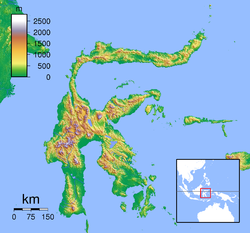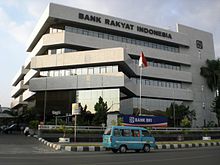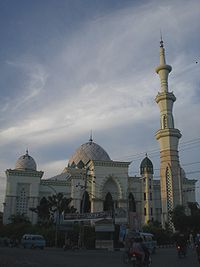- Makassar
-
For other uses, see Macassar (disambiguation).
Makassar
ᨀᨚᨈ ᨆᨀᨔᨑ
Kota MakassarCity of Makassar Losari Beach (top), Masjid Raya Makassar (center), Makassar skyline (bottom left), and Hasanuddin International Airport (bottom right) 
SealNickname(s): "Kota Daeng" Motto: Sekali Layar Terkembang Pantang Biduk Surut Ke Pantai Location of Makassar in Sulawesi Coordinates: 5°8′S 119°25′E / 5.133°S 119.417°E Country Indonesia Province South Sulawesi City November 9, 1607 belasan Government - Mayor Ir.H.Ilham Arief Sirajuddin,MM. - Deputy Mayor Supomo Guntur Area - Total 175.77 km2 (67.9 sq mi) Population (2010) - Total 1,334,090 - Density 7,590/km2 (19,657.9/sq mi) 2010 decennial census Time zone WITA (UTC+8) - Summer (DST) not observed (UTC+8) Area code(s) +62 411 Twin Cities - Qingdao  China
China- Hakodate  Japan
Japan- Wellington  New Zealand
New Zealand- Aden  Yemen
Yemen- Samarinda  Indonesia
Indonesia- Lismore  Australia
Australia- Peshawar  Pakistan
Pakistan- Banjarmasin  Indonesia
IndonesiaWebsite www.makassarkota.go.id www.visitmakassar.net Makassar, (Makassarese language: ᨀᨚᨈ ᨆᨀᨔᨑ sometimes spelled Macassar, Mangkasar) is the provincial capital of South Sulawesi, Indonesia, and the largest city on Sulawesi Island. From 1971 to 1999, the city was named Ujung Pandang, after a precolonial fort in the city, and the two names are often used interchangeably. The port city is located at 5°8′S 119°25′E / 5.133°S 119.417°ECoordinates: 5°8′S 119°25′E / 5.133°S 119.417°E, on the southwest coast of the island of Sulawesi, facing the Makassar Strait.
Its area is 175.77 km2 and has population of around 1.4 million.[1]
Contents
History
Beginning in the sixteenth century, Makassar was the dominant trading center of eastern Indonesia, and soon became one of the largest cities in island Southeast Asia. The Makassarese kings maintained a policy of free trade, insisting on the right of any visitor to do business in the city, and rejecting the attempts of the Dutch to establish a monopoly over the city.[2]
Sulawesi's colourful history is the story of spices and foreign merchants of mariners and sultans and of foreign power wresting control of the spice trade. Much of South Sulawesi's early history was written in old texts that can be traced back to the 13th and 14th centuries.
The first European settlers were the Portuguese sailors. When the Portuguese reached Sulawesi in 1511, they found Makassar a thriving cosmopolitan entre-port where Chinese, Arabs, Indians, Siamese, Javanese, and Malays came to trade their manufactured metal goods and fine textiles for precious pearls, gold, copper, camphor and spices - nutmeg, cloves and mace imported from the interior and the neighbouring Spice Islands of Maluku. By the 16th century, Makassar had become Sulawesi's major port and centre of the powerful Gowa and Tallo sultanates which between them had a series of 11 fortresses and strongholds and a fortified sea wall which extended along the coast.[2]
The arrival of the Dutch in the early 17th century, altered events dramatically. Their first objective was to create a hegemony over the spice trade and their first move was to capture the fort of Makassar in 1667, which they rebuilt and renamed Fort Rotterdam. From this base they managed to destroy the strongholds of the Sultan of Gowa who was then forced to live on the outskirts of Makassar. Following the Java War (1825–1830), Prince Diponegoro was exiled to Fort Rotterdam until his death in 1855.[3]
The character of this old trading centre changed as a walled city known as Vlaardingen grew, a place where slaves were at the bidding of the imposing foreigners. Gradually, in defiance of the Dutch, the Arabs, Malays and Bugis returned to trade outside the grim fortress walls and later also the Chinese.
The town again became a collecting point for the produce of eastern Indonesia - the copra, rattan, pearls, trepang and sandalwood and the famous oil made from bado nuts used in Europe as men's hair dressing - hence the anti-macassars (embroidered cloths placed at head rests of upholstered chairs).
Although the Dutch controlled the coast, it was not until the early 20th century that they gained power over the interior of the south through a series of treaties with local rulers. Meanwhile Dutch missionaries converted many of the Toraja people to Christianity. By 1938, the population of Makassar had reached around 84,000 - a town described by writer Joseph Conrad as "the prettiest and perhaps, cleanest looking of all the towns in the islands".
In World War II the Makassar area was defended by approximately 1000 men of the Royal Netherlands East Indies Army commanded by Colonel M. Vooren. He decided he couldn't defend on the coast and was planning to fight a guerilla war inland. The Japanese landed near Makassar on 9 February 1942. The defenders retreated but were soon overtaken & captured.[4]
Following the Indonesian National Revolution in 1950, Makassar was the site of fighting between pro-Federalist forces under Captain Abdul Assiz and Republican forces under Colonel Sunkono during the Makassar Uprising.[5] By the 1950s, the population had increased to such a degree that many of the historic sites gave way to modern development and today you need to look very carefully to find the few remains of the city's once grand history.
Further, tolerant religious attitudes meant that even as Islam became the dominant faith in the region, Christians and others were still able to trade in the city. With these attractions, Makassar was a key center for Malays working in the spice trade, as well as a valuable base for European and Arab traders from much further afield.
Economy
Bank Rakyat Indonesia's Makassar Branch Office, one of the largest banks operated in the city.
The city is southern Sulawesi's primary port, with regular domestic and international shipping connections. It is nationally famous as an important port of call for the pinisi boats, sailing ships which are among the last in use for regular long-distance trade.
During the colonial era, the city was famous for being the namesake of Makassar oil, which it exported in great quantity. Makassar ebony is a warm black hue, streaked with tan or brown tones, and highly prized for use in making fine cabinetry and veneers.
Nowadays, as the largest city in Sulawesi Island and Eastern Indonesia, the city's economy depends highly on service sectors with approximately 70% from total share. Restaurant and hotel service are the largest contributor (29.14%), followed by transportation and communication (14.86%), trading (14.86), finance (10.58%). Industry follows behind service with 21.34%.[6]
Contact with Australia
Main article: Macassan contact with AustraliaMakassar is also a major fishing center in Sulawesi. One of its major industries is the trepang (sea cucumber) industry. Trepang fishing brought the Makassan people into contact with the Yolŋu people of Northern Australia.
C. C. MacKnight in his 1976 work entitled Voyage to Marege: Macassan Trepangers in Northern Australia has shown that they began frequenting the north of Australia some time around 1700 in search of trepang (sea-slug, sea cucumber, Beche-de-mer) an edible Holothurian. They left their waters during the North-west Monsoon in December or January for what is now Arnhem Land, Marege or Marega and to the Kimberley region or Kayu Djawa. They returned home with the South-east Trades in April.[7] A fleet of between 24 and 26 Macassan prahus was seen in 1803 by the French explorers under Nicolas Baudin on the Holothuria Banks in the Timor Sea. In February 1803, Matthew Flinders in the Investigator met six prahus with 20-25 men each on board and was told that there were 60 prahus then on the north Australian coast. They were fishing for trepang and appeared to have only a small compass as a navigation aid. In June 1818 Macassan trepang fishing was noted by Phillip Parker King in the vicinity of Port Essington in the Arafura Sea. In 1864 R.J. Sholl, then resident magistrate for the European settlement at Camden Sound (near Augustus Island in the Kimberley region) observed seven ‘Macassan’ prahus with around 300 men on board. He believed that they made kidnapping raids and ranged as far south as Roebuck Bay (later Broome) where ‘quite a fleet’ was seen around 1866. Sholl believed that they did not venture south into other areas such as Nickol Bay (where the European pearling industry commenced around 1865) due to the absence of trepang in those waters. The Macassan voyages appear to have ceased sometime in the late nineteenth century and their place was taken by other sailors operating from elsewhere in the Indonesian Archipelago.
Transportation
Makassar has a public transportation system called 'pete-pete'. A pete-pete (known elsewhere in Indonesia as angkot) is a mini-bus that has been modified to carry passengers. The route of Makassar's pete-petes is denoted by the letter on the windshield. Makassar is famous for their "becak" (pedicab) which is smaller than the "becak" in the island of Java. In Makassar, people who drive pedicab are called Daeng. The city airport is Hasanuddin International Airport which is actually located outside the Makassar city administration area. It is formally located in the regency of Maros. In addition to "becak" and "pete-pete", the city has government-run bus system, and taxis.
A 35-kilometer monorail in the areas of Makassar, Maros, Sungguminasa, and Takalar (Mamminasata) will be realised in 2014 with cost predicted Rp.4 trillion ($468 million). The memorandum of understanding has been signed in July 25, 2011 by Makassar city, Maros Regency and Gowa Regency.[8][9]
Landmarks
Makassar is home to several prominent landmarks including the 16th century Dutch fort Fort Rotterdam, Trans Studio Makassar—the third largest indoor theme park in the world and the Karebosi Link—the first underground shopping center in Indonesia.
Traditional food
Makassar has several famous traditional foods. The most famous is Coto Makassar. It is a stew made from the mixture of nuts and spices with beef parts which include beef brain, tongue and intestine. Konro rib dish is also popular traditional food in Makassar. Both Coto Makassar and Konro are usually eaten with Burasa, a glutinous rice with coconut milk and sauted coconut granule.
In addition, Makassar is the home of pisang epe, or pressed bananas. These are bananas which are pressed, grilled, and covered with palm sugar sauce and sometimes eaten with Durian. Many street vendors sell pisang epe, especially around the area of Losari beach.
Tourism
Since 9 September 2009, Makassar was home to the Trans Kalla—the biggest indoor theme park in Southeast Asia and third largest in the world.[10] The theme park was created by a joint company between Trans TV and former Vice President Jusuf Kalla's company Kalla Group. Beside the Theme Park, it also has a tourist resort, a marina, a bank office, and a shopping center which will be completed around 2012. The theme park is located in Tanjung Bunga. The local government is planning to build a CPI which includes the Presidential House near the theme park.
In July 2010, the first exclusive shopping centre Trans Studio Mall which is just inside the Jusuf Kalla was opened. Some famous brands opening shops in the mall were Hugo Boss, Armani Jeans, Aigner, Mothercare, Mango, Tod's, Miu Miu, and Francesco Biasia. Other brands opened temporary stores to assess the market. This is the first shopping mall to have medium to high range stores and the target market is the people from eastern Indonesia.
See also
Notes
- ^ Andi Hajramurni: Autonomy Watch: Makassar grows with waterfront city concept, in The Jakarta Post, 13 June 2011
- ^ a b Andaya, Leonard. "Makasar's Moment of Glory." Indonesian Heritage: Early Modern History. Vol. 3, ed. Anthony Reid, Sian Jay and T. Durairajoo. Singapore: Editions Didier Millet, 2001. 58-59.
- ^ Carey, Peter. "Dipanagara and the Java War." Indonesian Heritage: Early Modern History. Vol. 3, ed. Anthony Reid, Sian Jay and T. Durairajoo. Singapore: Editions Didier Millet, 2001. 112-13.
- ^ L, Klemen (1999-2000). "The capture of Makassar, February 1942". Forgotten Campaign: The Dutch East Indies Campaign 1941-1942. http://www.dutcheastindies.webs.com/makassar.html.
- ^ Westerling (1952), p. 210
- ^ http://www.makassarterkini.com/index.php?option=com_content&view=article&id=163:pertumbuhan-ekonomi-makassar-membaik-&catid=44:info-terkini&Itemid=139
- ^ MacKnight
- ^ Mamminasata Railway Realised in 2015
- ^ http://www.thejakartapost.com/news/2011/07/25/makassar-neighbors-commence-monorail-construction-next-year.html
- ^ Word Biggest Indoor Theme Park - Trans Studio (September 09, 2009). http://worldmustbecrazy.blogspot.com/2009/09/world-biggest-indoor-theme-park-trans.html
References
- L, Klemen (1999-2000). "Forgotten Campaign: The Dutch East Indies Campaign 1941-1942". http://www.dutcheastindies.webs.com/index.html.
- MacKnight, C.C., Voyage to Marege. Macassan Trepangers in Northern Australia, Melbourne University Press, 1976.
- Reid, Anthony. 1999. Charting the shape of early modern Southeast Asia. Chiang Mai: Silkworm Books. ISBN 974-7551-06-3. pp. 100–154.
Further reading
- McCarthy, M., 2000, Indonesian divers in Australian waters. The Great Circle, vol. 20, No.2:120-137.
- Turner, S. 2003: Indonesia’s Small Entrepreneurs: Trading on the Margins. London, RoutledgeCurzon [ISBN 0 7007 1569 X] 288pp. Hardback.
- Turner, S. 2007: Small-Scale Enterprise Livelihoods and Social Capital in Eastern Indonesia: Ethnic Embeddedness and Exclusion. Professional Geographer. 59 (4), 407-20.
History Portuguese Empire North Africa15th century
1415–1640 Ceuta
1458–1550 Alcácer Ceguer (El Qsar es Seghir)
1471–1550 Arzila (Asilah)
1471–1662 Tangier
1485–1550 Mazagan (El Jadida)
1487– middle 16th century Ouadane
1488–1541 Safim (Safi)
1489 Graciosa16th century
1505–1769 Santa Cruz do Cabo
de Gué (Agadir)
1506–1525 Mogador (Essaouira)
1506–1525 Aguz (Souira Guedima)
1506–1769 Mazagan (El Jadida)
1513–1541 Azamor (Azemmour)
1515 São João da Mamora (Mehdya)
1577–1589 Arzila (Asilah)Sub-Saharan Africa15th century
1455–1633 Arguin
1470–1975 Portuguese São Tomé1
1474–1778 Annobón
1478–1778 Fernando Poo (Bioko)
1482–1637 Elmina (São Jorge
da Mina)
1482–1642 Portuguese Gold Coast
1496–1550 Madagascar (part)
1498–1540 Mascarene Islands16th century
1500–1630 Malindi
1500–1975 Portuguese Príncipe1
1501–1975 Portuguese E. Africa
(Mozambique)
1502–1659 St. Helena
1503–1698 Zanzibar
1505–1512 Quíloa (Kilwa)
1506–1511 Socotra
1557–1578 Portuguese Accra
1575–1975 Portuguese W. Africa
(Angola)
1588–1974 Cacheu2
1593–1698 Mombassa (Mombasa)17th century
1642–1975 Portuguese Cape Verde
1645–1888 Ziguinchor
1680–1961 São João Baptista de Ajudá
1687–1974 Portuguese Bissau2
18th century
1728–1729 Mombassa (Mombasa)
1753–1975 Portuguese São Tomé and Príncipe
19th century
1879–1974 Portuguese Guinea
1885–1975 Portuguese Congo1 Part of São Tomé and Príncipe from 1753. 2 Part of Portuguese Guinea from 1879. Southwest Asia16th century
1506–1615 Gamru (Bandar-Abbas)
1507–1643 Sohar
1515–1622 Hormuz (Ormus)
1515–1648 Quriyat
1515–? Qalhat
1515–1650 Muscat
1515?–? Barka
1515–1633? Julfar (Ras al-Khaimah)
1521–1602 Bahrain (Muharraq and Manama)
1521–1529? Qatif
1521?–1551? Tarut Island
1550–1551 Qatif
1588–1648 Matrah17th century
1620–? Khor Fakkan
1621?–? As Sib
1621–1622 Qeshm
1623–? Khasab
1623–? Libedia
1624–? Kalba
1624–? Madha
1624–1648 Dibba Al-Hisn
1624?–? Bandar-e KongIndian subcontinent15th century
1498–1545 Laccadive Islands
(Lakshadweep)16th century
Portuguese India
· 1500–1663 Cochim (Kochi)
· 1502–1661 Quilon (Coulão/Kollam)
· 1502–1663 Cannanore (Kannur)
· 1507–1657 Negapatam (Nagapatnam)
· 1510–1962 Goa
· 1512–1525 Calicut (Kozhikode)
· 1518–1619 Chaul
· 1523–1662 Mylapore
· 1528–1666 Chittagong
· 1531–1571 Chalium
· 1534–1601 Salsette Island
· 1534–1661 Bombay (Mumbai)
· 1535–1739 Baçaím (Vasai-Virar)
· 1536–1662 Cranganore (Kodungallur)
· 1540–1612 Surat
· 1548–1658 Tuticorin (Thoothukudi)16th century (continued)
Portuguese India (continued)
· 1559–1962 Daman and Diu
· 1568–1659 Mangalore
· 1579–1632 Hugli
· 1598–1610 Masulipatnam (Machilipatnam)
1518–1521 Maldives
1518–1658 Portuguese Ceylon (Sri Lanka)
1558–1573 Maldives
17th century
Portuguese India
· 1687–1749 Mylapore
18th century
Portuguese India
· 1779–1954 Dadra and Nagar HaveliEast Asia and Oceania16th century
1511–1641 Portuguese Malacca
1512–1621 Ternate
· 1576–1605 Ambon
· 1578–1650 Tidore
1512–1665 Makassar
1553–1999 Portuguese Macau
1571–1639 Decima (Dejima, Nagasaki)17th century
1642–1975 Portuguese Timor (East Timor)1
19th century
Portuguese Macau
· 1864–1999 Coloane
· 1849–1999 Portas do Cerco
· 1851–1999 Taipa
· 1890–1999 Ilha Verde
20th century
Portuguese Macau
· 1938–1941 Lapa and Montanha (Hengqin)1 1975 is the year of East Timor's Declaration of Independence and subsequent invasion by Indonesia. In 2002, East Timor's independence was recognized by Portugal & the world.
North America and the North Atlantic Ocean16th century
1500–1579? Terra Nova (Newfoundland)
1500–1579? Labrador
1516–1579? Nova ScotiaCentral and South America16th century
1500–1822 Brazil
1536–1620 Portuguese Barbados17th century
1680–1777 Nova Colônia do Sacramento
19th century
1808–1822 Cisplatina (Uruguay)Regencies and cities of South Sulawesi Capital: Makassar Regencies
Bantaeng • Barru • Bone • Bulukumba • Enrekang • Gowa • Jeneponto • Luwu • East Luwu • North Luwu • Maros • Pangkajene Islands • Pinrang • Selayar • Sinjai • Sidenreng Rappang • Soppeng • Takalar • Tana Toraja • Wajo

Cities
See also: List of regencies and cities of Indonesia Categories:- Makassar
- Former Portuguese colonies
- Populated places in South Sulawesi
- Port cities and towns in Indonesia
- South Sulawesi
- Cities in Indonesia
- Regency capitals of Indonesia
- Provincial capitals in Indonesia
Wikimedia Foundation. 2010.




